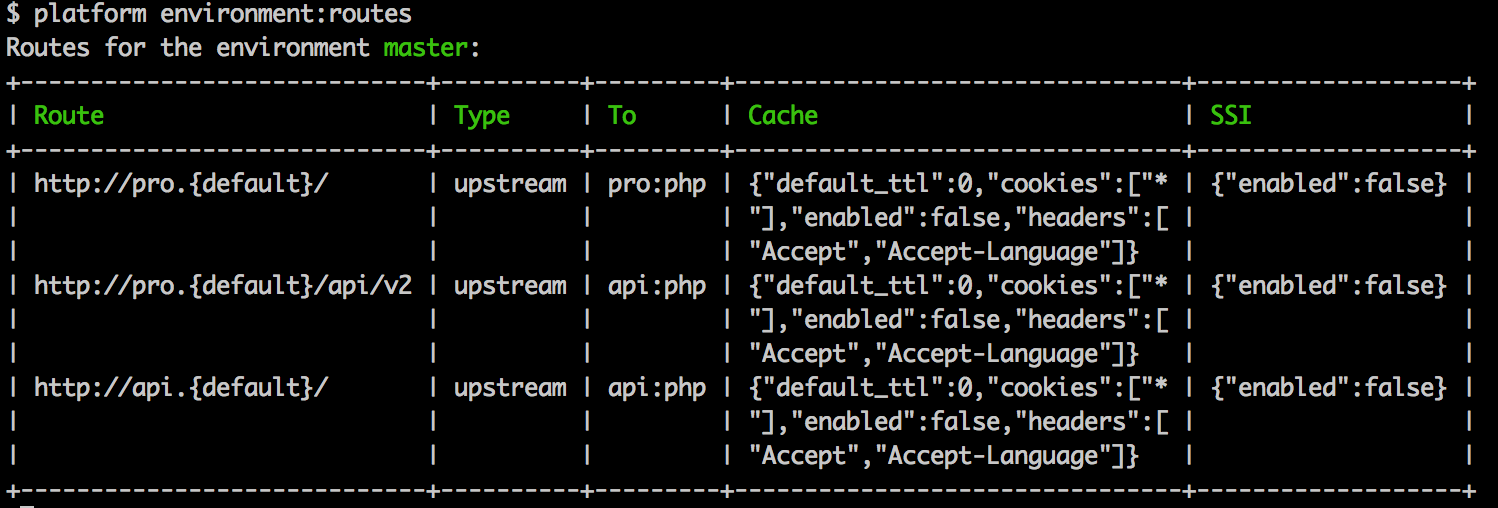.platform/routes.yaml
Configure Routes
Platform.sh allows you to define the routes that will serve your environments.
A route describes how an incoming URL is going to be processed by
Platform.sh. The routes are stored into a routes.yaml file which
should be added inside the .platform folder at the root of your Git
repository.
As you may know, Platform.sh is capable of both managing production environments, as of generating on-the-fly testing, development and staging environments. This single configuration file covers all of this.
If you don't have a .platform folder, you need to create one and create the
routes.yaml file:
$ mkdir .platform
$ touch .platform/routes.yaml
Route templates
The yaml file is composed of a list of templated routes, and their
configuration. A route template can look like this: http://www.{default}/ or
https://{default}/blog where {default} will be the fully qualified domain
name configured for the project. So if our domain would be example.com these
routes will get resolved to : http://www.example.com/ and
https://example.com/blog for live environment (the Master).
Platform.sh will also generate for every active environment urls that allow you
to test that environment, here {default} will be replaced with
[branch]-[project-id].[region].platform.sh so for a project with id
mswy7hzcuhcjw on a branch called refactorcss hosted in the us cluser we
will get: http://www---refactorcss-mswy7hzcuhcjw.us.platform.sh/ and
https://refactorcss-mswy7hzcuhcjw.us.platform.sh/blog
note Platform.sh also supports multiple applications per project. Each project has single
routes.yamlfile that defines which request will be routed to which application.
Route configuration
Each route can be configured separately its has the following properties
typecan be:upstreamserves an application- It will then also have an
upstreamproperty which will be the name of the application (as defined in.platform.app.yaml) followed by ":php" (see examples below).
- It will then also have an
redirectredirects to another route- It will then be followed by
toproperty, this is an HTTP redirection to another route that will be identified by its template (see examples below).
- It will then be followed by
cachecontrols caching for the route.ssicontrols whether Server Side Includes are enabled. For more information: see SSI.redirectscontrols redirect rules associated with the route.
note for the moment the upstream is always of this form, ending with ":php" in the future Platform.sh will support multiple endpoints per application.
Routes examples
Here is an example of a routes.yaml file:
"http://{default}/":
type: upstream
upstream: "frontend:php"
"http://www.{default}/":
type: redirect
to: "http://{default}/"
In this example we will route both the naked domain and the www subdomain to an application we called "frontend", the www subdomain being redirected to the naked domain. We aren't handling any HTTPS requests here.
In the following example we are not redirecting from the www to the naked domain but serving from both:
"http://{default}/":
type: upstream
upstream: "php:php"
"http://www.{default}/":
type: upstream
upstream: "php:php"
The difference between the two previous examples is that for the first one the
server will respond directly to a request of the form http://example.com/hello,
but it will issue a 301 redirect for http://www.example.com/foo_bar (to
http://example.com/foo_bar).
And here is an example wildcard configuration (see below for details on wildcard routes):
"http://*.{default}/":
type: upstream
upstream: "php:php"
You can see the Configuring Multiple Applications section for a detailed view of how this works with multiple applications in the same project.
Look at the redirects section for even more details on how you can set up complex redirection rules including partial redirects.
http://www.{default}/:
to: https://{default}/
type: redirect
http://{default}/:
to: https://{default}/
type: redirect
https://{default}/:
cache:
cookies:
- '*'
default_ttl: 0
enabled: true
headers:
- Accept
- Accept-Language
ssi:
enabled: false
type: upstream
upstream: php:php
Configuring routes on the Web Interface
For your convenience routes can also be configured using the web interface in the routes section of the environment settings .
CLI Access
You can get a list of the configured routes for an environment by running
$ platform environment:routes

Wildcard routes
Platform.sh supports wildcard routes, so you can map multiple subdomains to the
same application. This works both for redirect and upstream routes. You can
simply prefix the route with a star (*), for example *.example.com, and
www.example.com, blog.example.com, us.example.com will all get routed to the
same endpoint.
For your live environment this would function as a catch-all domain.
For environments that are not mapped to a domain (basically anything other than a live master) we will also be able to handle this. Here is how:
Let's imagine we have a project on the EU cluster whose id is vmwklxcpbi6zq and
we created a branch called "add-theme". Platform.sh will automatically be able
to route the url http://add-theme-vmwklxcpbi6zq.eu.platform.sh/ to this
environment. If, for example, we also defined a http://www.{default}/ route,
you could visit the following url to see
http://www---add-theme-vmwklxcpbi6zq.eu.platform.sh/ the same environment.
note notice the triple dash (
---) we use as a separator for the subdomain. This is what replaces the dot (.).
With a wildcard route this means that you could put anything before the triple
dashes. In our case if we have a http://*.{default}/ route, both
http://foo---add-theme-vmwklxcpbi6zq.eu.platform.sh/ and
http://bar---add-theme-vmwklxcpbi6zq.eu.platform.sh/ would work just fine.
If you examine the routes of your application (for example by running
echo $PLATFORM_ROUTES | base64 --decode | json_pp in an SSH session on your environment).
You will see a route such as https://*---add-theme-vmwklxcpbi6zq.eu.platform.sh/
You can find detailed information about caching here.
Defaults
If you do not have a routes.yaml file, the following default one will be loaded:
"http://{default}/":
type: upstream
upstream: "php:php"
cache:
enabled: true
ssi:
enabled: false
"http://www.{default}/":
type: redirect
to: "http://{default}/"